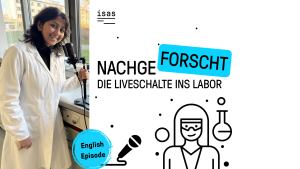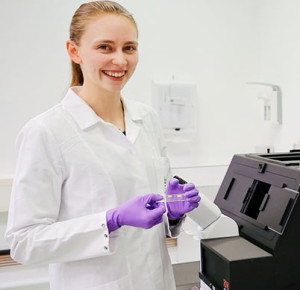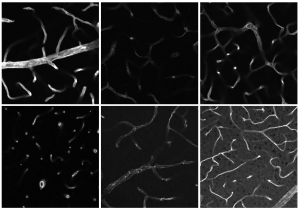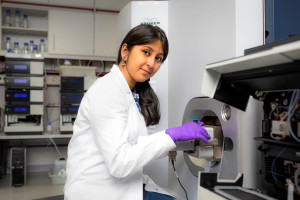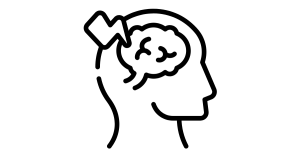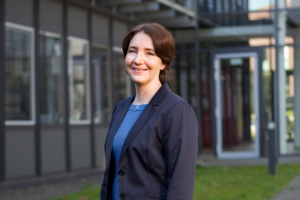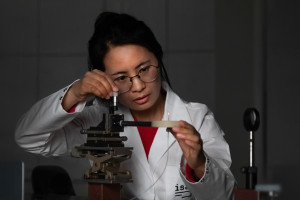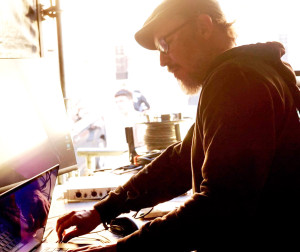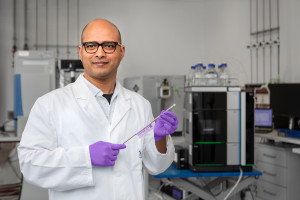Dortmund, 23rd July 2025
Dr Ali Ata Tuz completed his doctorate on the causes of immunodeficiency after strokes at the Institute of Experimental Immunology and Imaging (IEII) at University Hospital Essen. The results of his research, conducted in collaboration with ISAS, were published in the journal Nature Cardiovascular Research. Having studied medicine in Turkey, Tuz has thus now obtained his doctorate in medicine in Germany. Following his doctorate, his path led him to the Bioimaging working group at ISAS. The physician researched various imaging techniques – including confocal and light sheet fluorescence microscopy – to investigate the behaviour of immune cells as a postdoctoral researcher until June 2025.
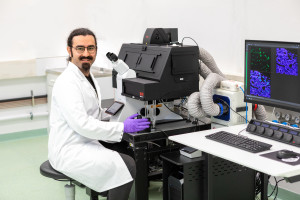
Dr Ali Ata Tuz uses a confocal microscope to prepare images of immune cells in tissue sections. He will later analyse the high-resolution pictures on the computer.
© ISAS / Hannes Woidich
1. How did your path lead you from medicine into application oriented basic research?
Tuz: Right from the beginning of my medical studies in Turkey, I was interested in basic research, and I am particularly fascinated by neuroscience. I want to know how our brain works. That's why during research visits as part of my studies, for example at Yale University in the USA or at the University of Heidelberg, I studied different types of neurological disease, brain tumours or certain cell types in the brain. There is still a lot that we don't know in this field. The combination of basic research methods and clinical questions was particularly fascinating for me here. My interest in neurological and neuroimmunological research then led me to my doctorate in Germany: I want to plan and carry out experiments myself and get to know the different research methods better instead of working only in the clinical field. At the IEII in Essen, I was able to combine neuroscience and imaging, the two aspects that interest me the most, during my doctorate. Even as a post-doctoral researcher at ISAS, I still work with various imaging methods, such as light sheet fluorescence microscopy.
2. How did you proceed during your doctorate to get to the bottom of the causes of immunodeficiency after a stroke or heart attack?
Tuz: The basic idea of my doctorate was always to apply the results later in the clinic. In this field of research, we already knew that patients often have problems with infections after a stroke, something that indicates an immunodeficiency. An important part of the research process is to constantly define new research questions based on initial hypotheses and later also on the results. So we asked ourselves why this immunodeficiency occurs. If we know the cause, we can identify specific points on the signalling pathway. Researchers can then develop drugs specifically for these “targets”. However, there are still a lot of unanswered questions before the findings can really be applied in the clinic. For example, different times of drug administration after a stroke and the dose of the drugs still need to be researched. It is also a normal part of research that we often expect certain results at the beginning and then something completely new emerges.
Article Recommendation
Tuz, A.A. Ghosh, S., Karsch, L., Ttoouli, D., Sata, S.P., Ulusoy, Ö., Kraus, A., Hoerenbaum, N., Wolf, J.-N., Lohmann, S., Zwirnlein, F., Kaygusuz, V., Lakovic, V., Tummes, H.-L., Beer, A., Gallert, M., Thiebes, S., Qefalia, A., Cibir, Z., Antler, M., Korste, S., Haj Yehia, E., Michel, L., Rassaf, T., Kaltwasser, B., Abdelrahman, H., Yusuf, A.M., Wang, C., Yin, D., Haeusler, L., Lueong, S., Richter, M., Engel, D.R., Stenzel, M., Soehnlein, O., Frank, B., Solo Nomenjanahary, M., Ho-Tin-Noé, B., Siveke, J.T., Totzeck, M., Hoffmann, D., Grüneboom, A., Hagemann, N., Hasenberg, A., Desilles, J.-P., Mazighi, M., Sickmann, A., Chen, J., Hermann, D.M., Gunzer, M., Singh, V.
(2024) Stroke and myocardial infarction induce neutrophil extracellular trap release disrupting lymphoid organ structure and immunoglobulin secretion. Nature Cardiovascular Research, Jg. 3, Nr. 5, S. 525–540.
3. In your work you combine various methods, such as different microscopy techniques, mass spectrometry or AI-based 3D image analysis. What role does interdisciplinary collaboration play in your research?
Tuz: The cooperation with the different research groups has helped me a lot in analysing questions from different perspectives, and thus to achieve better results. I carried out my doctorate under the supervision of Prof. Dr Matthias Gunzer, Director of the IEIB and Head of the Biospectroscopy department at ISAS. During that time I learned a lot about different microscopy techniques, for example. I was also able to learn a lot from scientists with different backgrounds who supported me, for example, with microscopy, analysing results or planning experiments with mouse models. At ISAS, I worked closely with the Bioimaging, AMBIOM and Proteomics research groups. Prof. Dr Anika Grüneboom, who is now my research group leader here at ISAS, helped us, for example, to carry out experiments with the confocal microscope and the light sheet fluorescence microscope. We also worked a lot with colleagues from the clinic because we also analysed blood and plasma samples from patients for the publication.
(The Interview was conducted by Anna Becker.)
